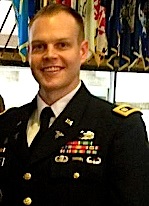U.S. Army Capt. David M. Barry has found himself at the forefront of cutting-edge research for improving methods for assessing and treating traumatic brain injury [TBI], delivering research findings that contain both professional and personal components at symposiums and forums.

The distinguished engineering graduate (summa cum laude, Engineering Science) from Vanderbilt’s Army ROTC program in 2006, has spent the last few years at the Ettenhofer Laboratory for Neurocognitive Research in Bethesda, Md., designing and testing eye-tracking systems in hopes of finding ways to safely and quickly identify mild traumatic brain injury. According to Department of Defense statistics, the most recent number of medical diagnoses of TBI occurring anywhere U.S. forces are located since 2000 is just shy of 270,000.
“Unfortunately, what that figure doesn’t indicate is the number of service members who sustained a concussion or head injury and went undiagnosed,” Barry said. “The science of concussion assessment and treatment is still evolving. There is much to be done.”
Barry acknowledges that his Vanderbilt education developed his strategic, interpersonal, and critical thinking skills necessary for lab research projects, but what he learned a few months after graduating – that he would serve as a combat engineer platoon leader with the 4th Infantry Division in Iraq and be responsible for planning and executing missions to find and remove improvised explosive devices (IEDs) – sharpened his focus.
“Clearly, there is a tremendous personal component to my research with traumatic brain injury. My previous job in the Army was to find and remove the very things that cause many of these head injuries,” Barry said. “Many of the soldiers I deployed with in 2008 are still conducting these missions, and I think about them constantly.”
Barry called roadside bomb detection work “exciting,” but now in his third year as a clinical psychology Ph.D. student at Uniformed Services University of the Health Sciences [also home to the Ettenhofer Lab] Capt. Barry’s work still is exciting, only significantly less stressful. As one of Mark Ettenhofer’s first graduate students, Barry got the chance to innovate and develop the lab’s research projects alongside him.
“My background as a Vanderbilt engineer has prepared me to not only succeed as a clinical psychologist, but also as an innovator and communicator of novel ideas,” said Barry, who is scheduled to complete an internship in 2014 and earn his Ph.D. in 2015.
“We’d spend hours in front of dry-erase whiteboards. We’d build something, test it, refine it, and repeat. Being a part of this lab is incredible,” Barry said. “It’s so exciting to build something that you think can make a major difference. I’m honored to have the opportunity to develop tools that can help our nation’s service members and veterans.”
Aided in part by a $4 million Department of Defense grant, what’s being done to help, in Barry’s own words, is this:
“Simply put, we are exploring relationships between eye movements and cognitive functions. We want to see what a person’s eye movements can tell us about their abilities in areas such as decision-making speed, higher-order planning, and attention, among others.
“Currently, we are researching how eye movements differ among people with and without a history of neurological injury or illness in hopes of using eye movements to safely and quickly identify cognitive dysfunction. We are also studying how eye movements can provide quantifiable indices of recovery after head injury.
“To achieve these research goals, the Ettenhofer Neurocognitive Research Lab and our partners have developed computer assessment tests, virtual reality driving simulators, and neuroimaging programs that incorporate eye movements into their designs.”
Barry hopes these designs will lead to earlier detection of TBI cases. “Advancements in assessment can inform more effective treatments, and more effective treatments can obviously help our people recover from brain injury,” he said. “Luckily, I’m working in a lab that studies both.”